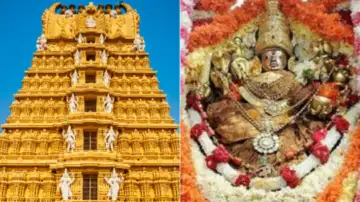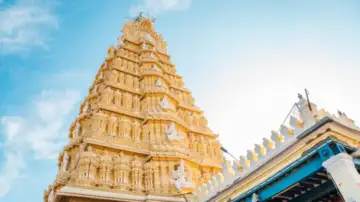Nestled high atop the Chamundi Hills, the temple is just 13 km away from Mysuru. Considered one of the most revered and architecturally beautiful temples in the Southern part of India, Sri Chamundeshwari Temple is not just a spiritual destination but a place steeped in legends, history, and culture.
The temple is dedicated to Goddess Chamundi, a fierce form of Shakti. The sacred place manages to draw thousands of devotees from all across the country and abroad. Whether you’re a firm believer in divine power or just a history geek who gets fascinated with the architecture, the temple promises an unforgettable experience.
Chamundeshwari Temple is steeped in mythology
Chamundeshwari Temple is dedicated to Goddess Chamundi, who is a powerful incarnation of Durga. Renowned for slaying demons like Chanda, Munda, the unbeatable Mahishasura, and the buffalo-headed asura, the goddess’s victory over evil is not celebrated in scriptures but ingrained deep in the design and name of the temple. The Chamundeshwari Devi Shaktipeetha is also known as Krouncha Pitham.
For many centuries now, Chamundi Devi has been the tutelary deity of the Mysore Royal Family, and the temple stands as a symbol of their devotion. The temple is recognised as one of the 18 Shakti Peethas, believed to be the spots where the parts of Sati’s body fell during Lord Shiva’s powerful tandav. The Gods and the Goddesses feared that Lord Shiva would destroy the universe in his rage. So, Lord Vishnu intervened, and with his chakra, he severed the body of Sati into multiple pieces. In this case, it is believed that her hair fell here, which also makes the site spiritually charged and sacred.

History of Chamundeshwari Temple
The origins of the temple date back to the 12th century, when it was constructed by the Hoysala rulers. Over the years, the sacred place evolved under various dynasties. The Vijayanagara Kings added the 7-tiered gopuram (temple tower) in the 17th century, and in 1659, Dodda Devaraja Wodeyar built the 1000 steps that led to the 3000-foot summit.
The temple is built in Dravidian-style architecture that features a quadrangular layout. The Chamundeshwari Temple has silver-plated doors, a sanctum sanctorum topped with Vimana, and a Navranga Hall. Devotees also found intricate carvings, spiritual symbols and images of gods throughout the temple.
One of the most eye-catching sights on the hill is the massive Nandi statue, which is located at the 700th step. The gigantic sculpture of Lord Shiva’s bull is 15 ft tall and 24 ft long, which is adorned with bells around its neck.
Legends behind the temple
One of the fascinating legend surround Chamaraja Wadiyar, who was struck by lightning while offering prayers at the temple in 1573. According to the popular folklore, the lightning almost burnt his hair. After that incident, he was called Bald Chamaraja Wadiyar by the locals.
Spiritual significance of Chamundeshwari Temple
The Chamundi Hills are believed to rise about 3489 ft above sea level. Inside the temple, you will find idols of Lord Ganesha, Lord Hanuman and Nandi, with each sculpture holding spiritual significance. The temple also houses a Simha Vahana (lion-shaped chariot), which was gifted by Krishnaraja Wodeyar III. During his reign in 1827, he renovated the temple and placed other vehicles too, which are now used for religious temple processions. Statues of his three wives, Ramavilasa, Lakshmivilasa and Krishnavilasa are also located on both sides.

It is believed that climbing all 1000 steps to the temple not only cleanses the past Karmic sins but tests one’s physical endurance too. The journey uphill is considered a form of penance, and reaching the top is a celebration in itself.
Many rulers have contributed to the development of the temple and offered various valuable jewels and items to Goddess Chamundeshwari. Now devotees make offerings of coconuts, fruits, and flowers to the deity.
The temple offers breathtaking views of Mysuru and the surrounding region, which is known as Trimuta Kshetra is said to be surrounded by eight sacred hills, with Chamundi Hill being one of the most prominent ones. Being surrounded by eight sacred hills. Originally referred to as Mahabaladri, in honour of the ancient Mahabaleshwara Temple, the hill was later renamed as Chamundi Hills after the goddess.
Disclaimer: This article is based on popular beliefs. Times Now is not responsible for the accuracy or completeness of the information and facts provided here.
